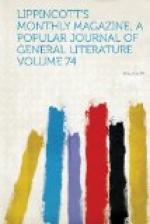One memorable morning brought to the unique little town a literary lion,—a woman of great heart, clear brain, and powerful pen,—in short, Harriet Martineau. Her travelling companions were a professor, his comely wife, and their eight-year-old son. The last-named was much petted by Miss Martineau, and still flourishes in perennial youth on many pages of her books of American travel. Michigan City felt honored in its transient guest. The whisper that a real live author was among us filled the inn hall with a changing throng eager to obtain a glimpse of the celebrity. Not among the least of these were “the two little girls” she mentions in her “Society in America,” page 253. At breakfast the party served their sharpened appetites quite like ordinary folk,—Miss Martineau in thoughtful quiet, broken now and again by a brisk question darted at the professor, who answered in a deliberate learned way that was quite impressive. A shiver of disgust ruffled his plump features at the absence of cream, which the host excused by the statement that, the population having outgrown its flocks and herds, milk was held sacred to the use of babes. Miss Martineau listened to the professor’s complaints with a twinkle of mirth in her eyes, while that indignant gentleman vigorously applied himself to the solid edibles at hand. Shortly after breakfast the strangers sallied forth in search of floral treasures, over the low sand-hills stretching toward the lake (a spur of which penetrated the main street), where in the face of the sandy drift nestled a shanty quite like the “dug-out” of the timberless lands in Kansas and New Mexico. The tomb-like structure, half buried in sand, only its front being visible, seemed to afford Miss Martineau no end of surprised amusement as she climbed to its submerged roof on her way to the summit of the hill. A window-garden of tittering young women merrily watched the progress of the quick-stepping Englishwoman, and, really, there was some provocation to mirth, from their stand-point. Anything approaching a blanket, plain, plaided, or striped, had never disported itself before their astonished gaze as a part of feminine apparel, except on the back of a grimy squaw. Of blanket-shawls, soon to become a staple article of trade, the Western women had not then even heard; and here was a civilized and cultivated creature enveloped in what seemed to be a gay trophy wrested from the bed-furniture! Then, too, the “only sweet thing” in bonnets was the demure “cottage,” fashioned of fine straw, while the woman in view sported a coarse, pied affair, whose turret-like crown and flaring brim pointed ambitiously skyward. Stout boots completed the costume criticised and laughed over by the merry maidens who yet stood in wholesome awe of the presence of the wearer. With what a wealth of gorgeous wild flowers and plumy ferns the pilgrims came laden on their return! Quoting from “Society in America,” page 253, Miss Martineau says, “The scene was like what I had always fancied the Norway coast, but for the wild flowers, which grew among the pines on the slope almost into the tide. I longed to spend an entire day on this flowery and shadowy margin of the inland sea. I plucked handfuls of pea-vine and other trailing flowers, which seemed to run all over the ground.”




